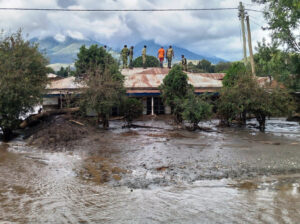by Ben Taylor
Deadly floods and landslides in Katesh
Early December 2023 saw extreme weather northern Tanzania that caused devastation in the small town of Katesh, in Hanang District, Manyara Region [see cover]. Heavy rains across the region had their worst impacts in Katesh and the nearby village of Gendabi, where a total 87 people were killed by floods and landslides. Around 100 more were injured, while homes, vehicles, livestock and agricultural land sustained extensive damage. An estimated 5,600 people have been left homeless.
Rescue efforts were coordinated by the government National Disaster Management Committee (NDMC) with the assistance of the military. Roads, bridges and communications infrastructure had also been badly damaged, hampering the work. A school in Katesh was used as an emergency refuge centre.
President Samia Suluhu Hassan cut short her attendance at the COP28 climate change conference in Dubai in order to visit the area. She described the disaster as “a wake-up call for the government to take the necessary measures to detect the signs and alert people in advance to avoid serious consequences like these.” She also expressed her dismay over people who continue to live in the flood prone lowlands and river valleys, especially in towns and cities.
President Hassan said new houses costing between TSh25 million to TSh30 million each would be constructed for the flood victims who lost their homes. “They will be resettled in entirely new areas and assisted to have their children back to school. These people lost everything including livestock and food stocks,” she said.
East Africa has been hit for weeks by torrential rains and floods linked to the El Niño weather phenomenon. Typically associated with rising temperatures, droughts in some parts of the world, and heavy rains in others, El Niño effects are expected to last until around April.
The disaster – and similar incidents elsewhere in East Africa – brought back memories of the rains and floods of 1997-1998, also an El Niño year, which left over 6,000 people dead across the region.
In this more recent case, the floods followed the worst drought in four decades. Scientists say extreme weather events such as flooding, storms, droughts and wildfires are being made longer, more intense and more frequent by human-induced climate change. (Al Jazeera, The Guardian, VoA, The Citizen)

